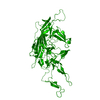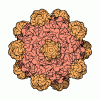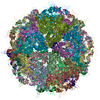+ Open data
Open data
- Basic information
Basic information
| Entry | Database: PDB / ID: 8a9u | ||||||
|---|---|---|---|---|---|---|---|
| Title | Full AAV3B-VP1KO virion | ||||||
 Components Components | Capsid protein VP1 | ||||||
 Keywords Keywords | VIRUS / Adeno-Associated Virus / AAV / AAV3B / AAV serotype 3B / Full / VP1KO | ||||||
| Function / homology | Phospholipase A2-like domain / Phospholipase A2-like domain / Parvovirus coat protein VP2 / Parvovirus coat protein VP1/VP2 / Parvovirus coat protein VP1/VP2 / Capsid/spike protein, ssDNA virus / T=1 icosahedral viral capsid / structural molecule activity / Capsid protein VP1 Function and homology information Function and homology information | ||||||
| Biological species |  Homo sapiens (human) Homo sapiens (human) | ||||||
| Method | ELECTRON MICROSCOPY / single particle reconstruction / cryo EM / Resolution: 3.1 Å | ||||||
 Authors Authors | Arriaga, I. / Abrescia, N.G.A. | ||||||
| Funding support | 1items
| ||||||
 Citation Citation |  Journal: Hum Gene Ther / Year: 2022 Journal: Hum Gene Ther / Year: 2022Title: Cellular and Structural Characterization of VP1 and VP2 Knockout Mutants of AAV3B Serotype and Implications for AAV Manufacturing. Authors: Iker Arriaga / Aitor Navarro / Amaia Etxabe / César Trigueros / R Jude Samulski / Philippe Moullier / Achille François / Nicola G A Abrescia /   Abstract: AAV virion biology is still lacking a complete understanding of the role that the various structural subunits (VP1, 2, and 3) play in virus assembly, infectivity, and therapeutic delivery for ...AAV virion biology is still lacking a complete understanding of the role that the various structural subunits (VP1, 2, and 3) play in virus assembly, infectivity, and therapeutic delivery for clinical indications. In this study, we focus on the less studied adeno-associated virus AAV3B and generate a collection of AAV plasmid substrates that assemble virion particles deficient specifically in VP1, VP2, or VP1 and 2 structural subunits. Using a collection of biological and structural assays, we observed that virions devoid of VP1, VP2, or VP1 and 2 efficiently assembled virion particles, indistinguishable by cryoelectron microscopy (cryo-EM) from that of wild type (WT), but unique in virion transduction (WT > VP2 > VP1 > VP1 and 2 mutants). We also observed that the missing structural subunit was mostly compensated by additional VP3 protomers in the formed virion particle. Using cryo-EM analysis, virions fell into three classes, namely full, empty, and partially filled, based on comparison of density values within the capsid. Further, we characterize virions described as "broken" or "disassembled" particles, and provide structural information that supports the particle dissolution occurring through the two-fold symmetry sites. Finally, we highlight the unique value of employing cryo-EM as an essential tool for release criteria with respect to AAV manufacturing. | ||||||
| History |
|
- Structure visualization
Structure visualization
| Structure viewer | Molecule:  Molmil Molmil Jmol/JSmol Jmol/JSmol |
|---|
- Downloads & links
Downloads & links
- Download
Download
| PDBx/mmCIF format |  8a9u.cif.gz 8a9u.cif.gz | 120 KB | Display |  PDBx/mmCIF format PDBx/mmCIF format |
|---|---|---|---|---|
| PDB format |  pdb8a9u.ent.gz pdb8a9u.ent.gz | 89.3 KB | Display |  PDB format PDB format |
| PDBx/mmJSON format |  8a9u.json.gz 8a9u.json.gz | Tree view |  PDBx/mmJSON format PDBx/mmJSON format | |
| Others |  Other downloads Other downloads |
-Validation report
| Summary document |  8a9u_validation.pdf.gz 8a9u_validation.pdf.gz | 1.1 MB | Display |  wwPDB validaton report wwPDB validaton report |
|---|---|---|---|---|
| Full document |  8a9u_full_validation.pdf.gz 8a9u_full_validation.pdf.gz | 1.1 MB | Display | |
| Data in XML |  8a9u_validation.xml.gz 8a9u_validation.xml.gz | 31.5 KB | Display | |
| Data in CIF |  8a9u_validation.cif.gz 8a9u_validation.cif.gz | 44.4 KB | Display | |
| Arichive directory |  https://data.pdbj.org/pub/pdb/validation_reports/a9/8a9u https://data.pdbj.org/pub/pdb/validation_reports/a9/8a9u ftp://data.pdbj.org/pub/pdb/validation_reports/a9/8a9u ftp://data.pdbj.org/pub/pdb/validation_reports/a9/8a9u | HTTPS FTP |
-Related structure data
| Related structure data |  15286MC M: map data used to model this data C: citing same article ( |
|---|---|
| Similar structure data | Similarity search - Function & homology  F&H Search F&H Search |
- Links
Links
- Assembly
Assembly
| Deposited unit | 
|
|---|---|
| 1 | x 60
|
- Components
Components
| #1: Protein | Mass: 66728.281 Da / Num. of mol.: 1 Source method: isolated from a genetically manipulated source Details: For pXR3b-VP1KO, the ATG start codon of VP1 was changed to TGA, and the GAT codon of Asp4 was changed to GAC to remove an alternative ATG. Thus this sample only has VP2 and VP3. Source: (gene. exp.)  Homo sapiens (human) / Plasmid: pXR3b / Details (production host): AAV2 rep and AAV3B cap genes / Cell line (production host): Pro10TM / Production host: Homo sapiens (human) / Plasmid: pXR3b / Details (production host): AAV2 rep and AAV3B cap genes / Cell line (production host): Pro10TM / Production host:  Homo sapiens (human) / References: UniProt: O56139 Homo sapiens (human) / References: UniProt: O56139 |
|---|---|
| Has protein modification | Y |
-Experimental details
-Experiment
| Experiment | Method: ELECTRON MICROSCOPY |
|---|---|
| EM experiment | Aggregation state: PARTICLE / 3D reconstruction method: single particle reconstruction |
- Sample preparation
Sample preparation
| Component | Name: Adeno-associated virus - 3 / Type: VIRUS Details: For the recombinant production of the VP1KO virion, we used the Pro10TM cell line. Entity ID: all / Source: RECOMBINANT |
|---|---|
| Source (natural) | Organism:  Adeno-associated virus - 3 / Strain: 3B Adeno-associated virus - 3 / Strain: 3B |
| Source (recombinant) | Organism:  Homo sapiens (human) Homo sapiens (human) |
| Details of virus | Empty: YES / Enveloped: NO / Isolate: SEROTYPE / Type: VIRION |
| Natural host | Organism: Homo sapiens |
| Virus shell | Diameter: 260 nm / Triangulation number (T number): 1 |
| Buffer solution | pH: 7.4 |
| Specimen | Embedding applied: NO / Shadowing applied: NO / Staining applied: NO / Vitrification applied: YES / Details: VP1KO 4.23E+13 vg/ml |
| Specimen support | Grid material: COPPER / Grid mesh size: 300 divisions/in. / Grid type: Quantifoil R1.2/1.3 |
| Vitrification | Instrument: FEI VITROBOT MARK III / Cryogen name: ETHANE / Humidity: 85 % / Chamber temperature: 283 K Details: Parameters: 2 seconds of blot time, -2 offset value, after 45 seconds of incubation. Quantifoil Cu 300-mesh R1.2/1.3 holey-carbon grids with an extra layer of carbon on top added in-house. |
- Electron microscopy imaging
Electron microscopy imaging
| Microscopy | Model: TFS GLACIOS |
|---|---|
| Electron gun | Electron source:  FIELD EMISSION GUN / Accelerating voltage: 200 kV / Illumination mode: FLOOD BEAM FIELD EMISSION GUN / Accelerating voltage: 200 kV / Illumination mode: FLOOD BEAM |
| Electron lens | Mode: BRIGHT FIELD / Nominal magnification: 92000 X / Nominal defocus max: 2500 nm / Nominal defocus min: 1000 nm |
| Image recording | Electron dose: 50 e/Å2 / Film or detector model: FEI FALCON III (4k x 4k) / Num. of real images: 2384 |
- Processing
Processing
| Software | Name: PHENIX / Version: 1.20.1_4487: / Classification: refinement | ||||||||||||||||||||||||||||||||
|---|---|---|---|---|---|---|---|---|---|---|---|---|---|---|---|---|---|---|---|---|---|---|---|---|---|---|---|---|---|---|---|---|---|
| EM software |
| ||||||||||||||||||||||||||||||||
| CTF correction | Type: PHASE FLIPPING AND AMPLITUDE CORRECTION | ||||||||||||||||||||||||||||||||
| Particle selection | Num. of particles selected: 401717 | ||||||||||||||||||||||||||||||||
| Symmetry | Point symmetry: I (icosahedral) | ||||||||||||||||||||||||||||||||
| 3D reconstruction | Resolution: 3.1 Å / Resolution method: FSC 0.143 CUT-OFF / Num. of particles: 340947 / Symmetry type: POINT | ||||||||||||||||||||||||||||||||
| Atomic model building | Protocol: RIGID BODY FIT / Space: REAL | ||||||||||||||||||||||||||||||||
| Atomic model building | PDB-ID: 3KIC Accession code: 3KIC / Source name: PDB / Type: experimental model | ||||||||||||||||||||||||||||||||
| Refinement | Highest resolution: 3.1 Å | ||||||||||||||||||||||||||||||||
| Refine LS restraints |
|
 Movie
Movie Controller
Controller




 PDBj
PDBj



